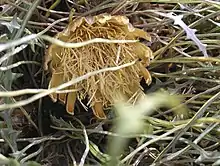| Banksia corvijuga | |
|---|---|
 | |
| Near Lake Grace | |
| Scientific classification | |
| Kingdom: | Plantae |
| Clade: | Tracheophytes |
| Clade: | Angiosperms |
| Clade: | Eudicots |
| Order: | Proteales |
| Family: | Proteaceae |
| Genus: | Banksia |
| Subgenus: | Banksia subg. Banksia |
| Series: | Banksia ser. Dryandra |
| Species: | B. corvijuga |
| Binomial name | |
| Banksia corvijuga | |
| Synonyms[1] | |
|
Dryandra corvijuga A.S.George | |
Banksia corvijuga is a species of densely-foliaged shrub that is endemic to Western Australia. It has broadly linear, serrated leaves, heads of about sixty yellow flowers and glabrous follicles.
Description
Banksia corvijuga is a densely-foliaged shrub that typically grows to a height of 1.3 m (4 ft 3 in) but does not form a lignotuber. It has serrated, broadly linear leaves that are 100–200 mm (3.9–7.9 in) long and 5–14 mm (0.20–0.55 in) wide on a thin petiole 20–60 mm (0.79–2.36 in) long, with between ten and twenty-five triangular teeth on each side. The flowers are borne on a head containing about sixty flowers with broadly linear to egg-shaped, dark reddish brown involucral bracts 40–50 mm (1.6–2.0 in) long at the base of the head. The flowers are yellow with a perianth 38–41 mm (1.5–1.6 in) long and a pistil 44–46 mm (1.7–1.8 in) long. Flowering occurs from September to October and the fruit is a glabrous, elliptical to egg-shaped follicle about 15 mm (0.59 in) long.[2][3][4]
Taxonomy and naming
This banksia was first formally described in 1996 by Alex George in the journal Nuytsia and given the name Dryandra corvijuga from specimens collected in 1986 near Ravensthorpe.[2][5] In 2007, Austin Mast and Kevin Thiele transferred all the dryandras to the genus Banksia and this species became Banksia corvijuga.[6][7] The specific epithet (corvijuga) is derived from Latin words meaning "a crow or raven" and "paired or yoked together", referring to the Ravensthorpe Range.[2]
Distribution and habitat
Banksia corvijuga grows in dense shrubland in the Ravensthorpe Range.[2][4]
Conservation status
This banksia is classified as "Priority Three" by the Government of Western Australia Department of Parks and Wildlife[4] meaning that it is poorly known and known from only a few locations but is not under imminent threat.[8]
References
- 1 2 "Banksia corvijuga". Australian Plant Census. Retrieved 17 April 2020.
- 1 2 3 4 George, Alex S. (1996). "New taxa and a new infrageneric classification in Dryandra R.Br". Nuytsia. 10 (3): 365.
- ↑ George, Alex S. (1999). Flora of Australia (PDF). Vol. 17B. Canberra: Australian Biological Resources Study, Canberra. p. 306. Retrieved 14 April 2020.
- 1 2 3 "Banksia corvijuga". FloraBase. Western Australian Government Department of Biodiversity, Conservation and Attractions.
- ↑ "Dryandra corvijuga". APNI. Retrieved 17 April 2020.
- ↑ "Banksia corvijuga". APNI. Retrieved 17 April 2020.
- ↑ Mast, Austin R.; Thiele, Kevin (2013). "The transfer of Dryandra R.Br. to Banksia L.f. (Proteaceae)". Australian Systematic Botany. 20 (1): 63–71. doi:10.1071/SB06016.
- ↑ "Conservation codes for Western Australian Flora and Fauna" (PDF). Government of Western Australia Department of Parks and Wildlife. Retrieved 17 April 2020.
